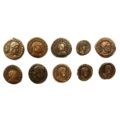Description
Constantine the Great was the first Christian Emperor of Rome, the founder of the Byzantine Empire and its capital city of Constantinople, and arguably the most historically
significant Roman ruler of the Common Era. In 312, while at battle, Constantine had a vision of a flaming cross in the sky at noon. He interpreted this as a sign that he should engage his legions in a holy war to wrest control of the entire Roman Empire, and to proclaim Christianity as the state religion. Guided by divine inspiration, he succeeded, winning territory from the Franks, the Visigoths, and the Sarmatians, and expanding imperial territory. His other accomplishments
include issuing the Edict of Milan, which made Christianity legal; working with Pope Sylvester I to establish the Papacy in Rome; and building the Old St. Peter’s Basilica, the Church of the Holy Sepulchre, and the Arch of Constantine.
When Constantine took the throne upon the death of his father, Constantius I Chlorus, Rome was in the midst of political and economic chaos—a period his reign helped end. He put down his rival Licinius I and his son Licinius II, consolidating his power. His sons—Constantine II, Constans I, and Constantius II—all ascended to the throne, establishing the Constantine Dynasty, the most significant since the days of Caesar Augustus. Another son, Crispus, also had coins minted with his portrait, as did his nephew Constantine Gallus. Julian II, was the last of the House of Constantine.
This collection contains ten coins:
1/ Constantius I Chlorus, 305-6
2/ Constantine the Great, 306-337
3/ Licinius I, 308-324;
4/ Licinius II, 317-24
5/ Crispus, 317-326
6/ Constantine II, 337-340
7/ Constans, 337-350
8/ Constantius II, 337-361
9/ Constantius Gallus, 351-54;
10/ Julian II, 360-363

















